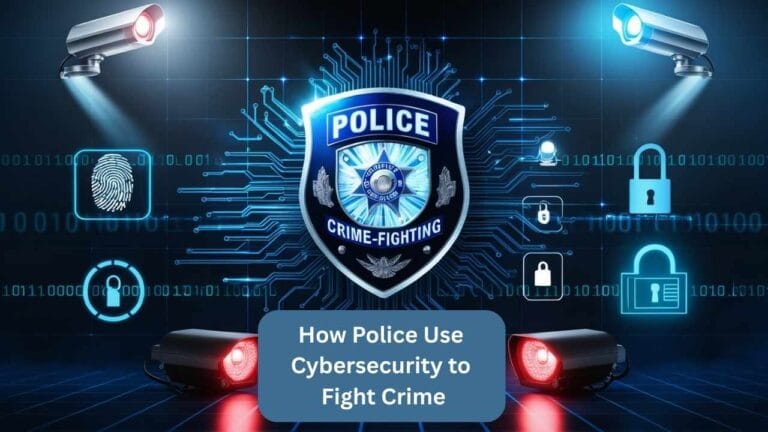Cybercrime now accounts for over $8 trillion in global losses annually, but law enforcement is fighting back with cutting-edge cybersecurity tactics. From tracking dark web drug rings to intercepting ransomware attacks before they happen, police departments worldwide are transforming into digital defense forces. Here’s how they’re doing it, and what you can learn from their playbook to protect yourself.
Most people picture police work as foot chases and fingerprint dusting, but modern crime fighting looks more like a tech startup. Take Detective Sarah M. (name changed for security), who cracked a child exploitation ring by analyzing metadata in deleted Telegram messages. “We used to chase leads on the street,” she told me. “Now we follow digital footprints, they never lie.” Let’s explore the tools making this possible.
Digital Forensics: Uncovering Digital Evidence
Digital forensics is a critical component of modern policing. It involves the collection, preservation, and analysis of electronic data to investigate crimes. This process enables law enforcement to retrieve evidence from computers, mobile devices, and other digital storage mediums.
For instance, analyzing a suspect’s smartphone can reveal communication records, location data, and internet activity, providing valuable insights into criminal activities. Digital forensics also plays a vital role in cybercrime investigations, such as tracking unauthorized access to systems or identifying the source of malicious software.
“Cybercrime Is Invisible”: Here’s How Police See What You Can’t
Police use advanced cyber forensics to turn invisible digital traces into airtight evidence.
While Hollywood shows hackers typing furiously on glowing screens, real cyber-investigations rely on:
- Metadata analysis: Every file, email, or social post leaks clues (timestamps, locations, device IDs). A 2024 INTERPOL report found 73% of solved cybercrimes relied on metadata.
- Blockchain forensics: 40% of ransomware payments are now traced through cryptocurrency ledgers using tools like Chainalysis.
- Dark web surveillance: Police run undercover bot accounts that monitor illegal marketplaces 24/7.
Case Study: The takedown of the “Hive” ransomware group involved:
- FBI agents infiltrating their communication channels
- Recovering decryption keys from seized servers
- Reversing $130M in Bitcoin transactions
Lesson: Cybercrime leaves trails, just not the kind you can see with the naked eye.
The Hidden Weapon: Artificial Intelligence Predicts Crime
AI doesn’t just solve crimes, it stops them before they happen.
A 2025 Cambridge study showed AI-powered policing reduces cyberattacks by 31% through:
- Behavioral pattern recognition (e.g., spotting phishing email templates)
- Threat intelligence sharing between global agencies
- Real-time anomaly detection in bank transactions
Real-World Example:
- NYPD’s “DeepAlarm” system flagged a repeating
- 9,999wiretransferpattern – uncoveringa
- 9,999wiretransferpattern – uncoveringa4M elder fraud ring. The perpetrators were arrested mid-scam.
Try This: Banks use similar AI to detect fraud. Enable “unusual activity” alerts on your accounts.
“Encryption Helps Criminals”: The Myth That Backfires
Strong encryption actually aids police work, when used ethically.
Myth: “End-to-end encryption (E2EE) lets criminals hide.”
Reality: Police work with tech firms to:
- Preserve encrypted evidence integrity
- Use legal warrants for metadata (not message content)
- Track device-level vulnerabilities (like unpatched iOS exploits)
2024 Europol Data:
- 68% of child exploitation cases were solved using encrypted platform cooperation (Signal, WhatsApp)
- 0% required “backdoor” access
Visualize This: Encryption is like a sealed evidence locker, only opened with a court order.
Your Action Plan: 5 Cyber-Hygiene Tips from Police
Follow this digital defense routine used by cybercrime units:
Phase 1: Fortify Your Base
- Enable MFA everywhere (90% of hacked accounts lack it)
- Update devices weekly (Police exploit unpatched systems to track criminals, don’t be their loophole)
Phase 2: Monitor Like a Detective
- Freeze your credit (Stops identity theft cold)
- Use breach alerts (HaveIBeenPwned.com)
Phase 3: Advanced Tactics
- VPN + Tor for sensitive work (Yes, cops use them too)
- Signal for private chats (Endorsed by FBI whistleblowers)
The Future of Cyber-Policing
Cybersecurity has become an integral part of modern policing, enabling law enforcement to address the complexities of digital crime effectively. Through digital forensics, AI, specialized units, partnerships, and community engagement, police enhance their capabilities to protect society in the digital age.
As technology continues to evolve, law enforcement must remain agile, embracing innovation and collaboration to stay ahead of cybercriminals. By doing so, they ensure the safety and security of communities in an increasingly interconnected world.
By 2026, expect:
AI “copilots” drafting search warrants in minutes
Satellite-level ISP tracking of cyberattack origins
Self-destructing digital evidence to prevent leaks
Final Thought:
As Detective Danial told me: “The best cybersecurity tool? A skeptical mind. Criminals prey on trust, verify everything.”





